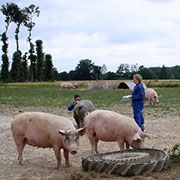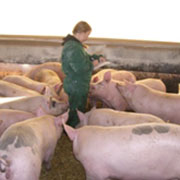ProPIG



More about the project
Main results and conclusions
ProPIG consists of 9 partners in 8 countries (AT, CH, CZ, DE, DK, FR, IT, UK) with the aim to assess and improve animal welfare and environmental impact of organic pig farming:
- Three husbandry systems: indoor with outside run (IN) / partly outdoor (POUT) / outdoor (OUT) were defined and compared.
- Standard Operating Procedures (‘SOPs’) were created for Feed- and Soil Sampling and the process of assessment and feedback (‘Health and welfare planning’).
- Animal welfare assessment protocols were developed based on WelfareQuality® and CorePIG. Together with questions regarding environmental impact, nutrition and economy these were integrated into an
- Automated Recording and Feedback Software Tool (‘PigSurfer’= PIG SURveillance, FEedback and Reporting), a software tool enabling on-farm data collection and immediate feedback (including presentation of data as benchmarking) using a tablet computer.
- Farm visits: After repeated observer training, three visits were carried out, in AT (16 farms), DE (16), DK (11) CH (9), CZ (1), FR (4), IT (9) and UK (8). During the first visit the farmer was interviewed, animals assessed, medicine and productivity records collected and feed and soil samples taken. Results were discussed with each farmer and farm specific goals and measures were agreed during the second visit. Using ‘PigSurfer’ during the final visit, it was possible to assess animal health, welfare, nutrition and feed the results back immediately to farmers as ‘farm plans’ including benchmarking across all 74 pig farms.
As a result two practical tools for further use by farmers and advisors were created:
- A ‘Catalogue of improvement strategies’ (COIS) for animal welfare challenges was developed based on expert opinion as well as farmers strategies. This was transferred into a ‘Handbook for Farmers’, a hard cover ring-binder, allowing practical application on farm.
- Furthermore a ‘Decision support tool for environmental impact’ (‘EDST’) was created in the form of an interactive spreadsheet, which identifies areas of possible improvement regarding environmental impact through a structured questionnaire, suggests measures which might be beneficial and provides information on where to find more detailed resources.
Generally based on the parameters assessed, it was shown, that a high level of animal health and welfare was found in most farms, with a few parameters which should be improved across all systems (e.g. vulva deformation from previous injury in sows). When comparing the three husbandry systems, OUT weaners and fatteners had better health regarding respiratory problems and diarrhoea and OUT sows less MMA and lameness, with POUT having some advantages as well over IN (e.g. lameness of sows). Regarding productivity, losses of piglets did not differ across systems; mortality of IN fattening pigs was lower than in POUT and their feed conversion rate was better.
Life Cycle Assessment (LCA) of global warming potential (GWP) was influenced mainly by feeding of fattening pigs and variation within a husbandry system was higher than between systems, indicating that good values can be achieved in all systems.
Regarding acidification potential (AP) POUT were better than IN and regarding eutrophication potential (EP) POUT were better than OUT.
Three clusters were identified on the basis of environmental impact, a ‘high, ‘medium’ and ‘lower’ with similar numbers of each husbandry system in all three of them.
The three systems did not differ regarding N balances. After clustering, N import from feed purchase was identified as main influencing factor. IN were significantly lower than POUT/OUT regarding P balances.
No significant relationship between health, welfare and environmental impacts was found when comparing the LCA clusters with an ‘animal health and welfare score’ (‘%GOOD’), individual animal based parameters or correlations between AP/EP/GWP and the ‘%GOOD.
Farm specific strategies were evaluated by farmers’ opinion and assessing within-farm improvement in measured criteria over 12 months. The median number of aims per farm was 2 (1 to 4), with fertility, nutrition, health and lesions most commonly addressed. In total 74.8 % of measures were partly/completely implemented and 81.6 % of goals were partly/completely achieved.
ProPIG
 Coordinator
Coordinator
Dr. med. vet. CertWEL Senior Scientist Christine Leeb, University of
Natural Ressources and
Applied Life Sciences, Austria.
Contact: christine.leeb@boku.ac.at
Involved Partners
Czech: IAS Institute of Animal Science; Gudrun Illmann and affiliated partner: BIO-I: Dipl.-Ing- (Agr.)/ Organic adviser Jiri Urban
Denmark: DJF-AU Department of Animal Health and Bioscience, Aarhus University Denmark; Senior scientist Tine Rousing
France: INRA Institut National de la Recherche Agronomique; Senior scientist Dr. Armelle Prunier
Germany: FLI Friedrich-Loeffler-Institut; Dr. Sabine Dippel
Italy: SUI Agricultural research council- Research unit for swine husbandry; MVD PhD Davide Bochicchio
Switzerland: FiBL Research Institute of Organic Agriculture Switzerland; Dipl. Ing. (FH) Barbara Früh
United Kingdom: NU Newcastle University; Lecturer in Livestock Production Systems Gillian Butler
Project stakeholders
Organic pig breeding and pig fattening farmers, organic and conventional advisors and veterinarians in all participating countries. All participating institutions will expand their networks across disciplines, being involved in animal welfare, nutrition and environmental impact. Also the transdiciplinary approach connects advisory structures and researchers.
The knowledge gained and the tools developed will benefit similarly farmers, advisors and veterinarians in other countries.
The outcomes can benefit (national) stakeholders such as organic associations, agricultural chambers and ministries across Europe. Also the scientific community is targeted by aiming to publish the results in scientific journals.
